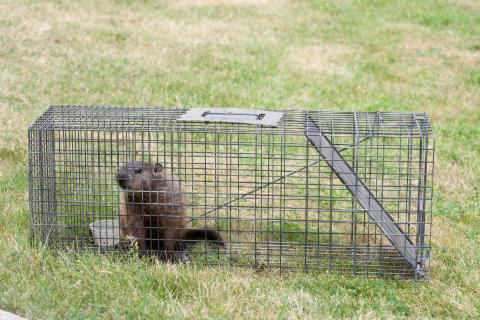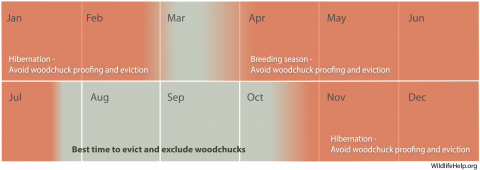Find help...
How to trap and remove problem woodchucks in Maine | Woodchuck
Maine > Animal is eating my garden plants and vegetables > Woodchuck
How to trap and remove problem woodchucks
Step 1
You can trap a woodchuck using a wire cage trap or wooden box trap with minimum dimensions of 10” x 12” x 32”, either single or double door, with the double considered very effective when set as a pass through trap. Set traps at main burrow entrances or along major travel lanes. Use trap covers during hot weather to provide shade as woodchucks are highly vulnerable to heat stress. Bait the trap with apple slices, cantaloupe, other fruits or vegetables such as carrots and lettuce, or use professional paste baits. Change or refresh baits daily.
When food is abundant, woodchucks may not respond to bait. In that case, wire the trap door and bait the trap. After the woodchuck takes the bait once or twice, add new bait and set the trap. Unbaited cage traps set near openings with boards or logs to guide the woodchuck are also effective.
Since woodchucks are active during the day, set the trap in the morning and close or remove it during the night; this will minimize the likelihood of catching a non-target animal that is active at night. Check all traps twice daily, morning and evening, so that captured animals may be quickly removed.
Step 2
When relocating problem woodchucks, take into account the breeding season and the potential for young being left behind. If possible, delay removing the mother until the young are active. Relocation and release of woodchucks is not recommended because the chance of survival is poor. If the animal is released, it should be relocated at least five miles away from the trap site and in an area of suitable habitat where it is unlikely to cause damage problems.
Laws and regulations to be aware of
While we attempt to provide guidance about state and federal regulations pertaining to specific species and control techniques, we do not provide information about local jurisdictions (city, town, county, etc.) where regulations may be more restrictive, especially as it applies to discharge of firearms, transport of animals or use of trapping equipment. Contact your local city or county government to inquire further. No guarantee is made that information (or lack of information) associated with a species or control technique is completely accurate or current. You should become familiar with federal, state and local laws before beginning any wildlife control activities. |
More solutions for woodchuck problems


